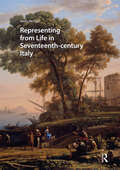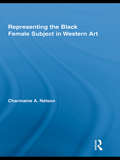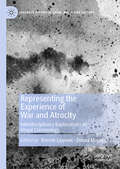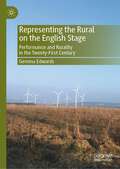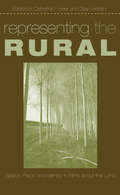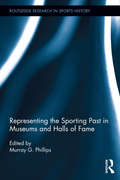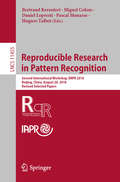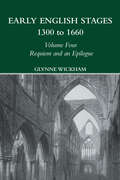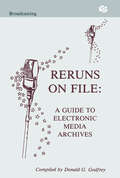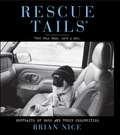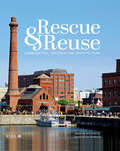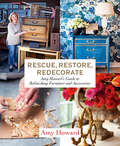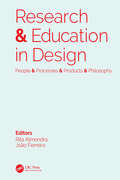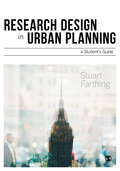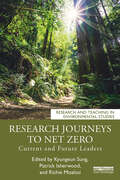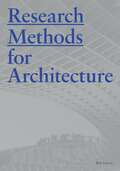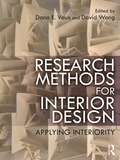- Table View
- List View
Representing from Life in Seventeenth-century Italy (Visual and Material Culture, 1300-1700)
by Sheila McTigheIn drawing or painting from live models and real landscapes, more was at stake for artists in early modern Italy than achieving greater naturalism. To work with the model in front of your eyes, and to retain their identity in the finished work of art, had an impact on concepts of artistry and authorship, the authority of the image as a source of knowledge, the boundaries between repetition and invention, and even the relation of images to words. This book focuses on artists who worked in Italy, both native Italians and migrants from northern Europe. The practice of depicting from life became a self-conscious departure from the norms of Italian arts. In the context of court culture in Rome and Florence, works by artists ranging from Caravaggio to Claude Lorrain, Pieter van Laer to Jacques Callot, reveal new aspects of their artistic practice and its critical implications.
Representing the Black Female Subject in Western Art (Routledge Studies on African and Black Diaspora)
by Charmaine A. NelsonThis book offers the first concentrated examination of the representation of the black female subject in Western art through the lenses of race/color and sex/gender. Charmaine A. Nelson poses critical questions about the contexts of production, the problems of representation, the pathways of circulation and the consequences of consumption. She analyzes not only how, where, why and by whom black female subjects have been represented, but also what the social and cultural impacts of the colonial legacy of racialized western representation have been. Nelson also explores and problematizes the issue of the historically privileged white artistic access to black female bodies and the limits of representation for these subjects. This book not only reshapes our understanding of the black female representation in Western Art, but also furthers our knowledge about race and how and why it is (re)defined and (re)mobilized at specific times and places throughout history.
Representing the Experience of War and Atrocity: Interdisciplinary Explorations in Visual Criminology (Palgrave Studies in Crime, Media and Culture)
by Emma Murray Ronnie LippensThis book explores how the experience of war and related atrocities tend to be visually expressed and how such articulations and representations are circulated and consumed. Each chapter of this volume examines how an image can contribute to a richer understanding of the experience of war and atrocity and thus they contribute to the burgeoning field of the "criminology of war". Topics include the destruction of war in oppositional cultural forms - comparing the Nazi period with the ISIS destruction of Palmyra - and the visual aesthetics of violence deployed by Jihadi terrorism. The contributors are a multi-disciplinary team drawn mainly from criminology but also sociology, international relations, gender studies, English and the visual arts. This book will advance this field in new directions with refreshing, original work.
Representing the Past in the Art of the Long Nineteenth Century: Historicism, Postmodernism, and Internationalism (Routledge Research in Art History)
by Matthew C. PotterThis edited collection explores the intersection of historical studies and the artistic representation of the past in the long nineteenth century. The case studies provide not just an account of the pursuit of history in art within Western Europe but also examples from beyond that sphere. These cover canonical and conventional examples of history painting as well as more inclusive, ‘popular’ and vernacular visual cultural phenomena. General themes explored include the problematics internal to the theory and practice of academic history painting and historical genre painting, including compositional devices and the authenticity of artefacts depicted; relationships of power and purpose in historical art; the use of historical art for alternative Liberal and authoritarian ideals; the international cross-fertilisation of ideas about historical art; and exploration of the diverse influences of socioeconomic and geopolitical factors. This book will be of particular interest to scholars of the histories of nineteenth-century art and culture.
Representing the Past in the Art of the Long Nineteenth Century: Historicism, Postmodernism, and Internationalism (Routledge Research in Art History)
by Matthew C. PotterThis edited collection explores the intersection of historical studies and the artistic representation of the past in the long nineteenth century. The case studies provide not just an account of the pursuit of history in art within Western Europe but also examples from beyond that sphere. These cover canonical and conventional examples of history painting as well as more inclusive, ‘popular’ and vernacular visual cultural phenomena. General themes explored include the problematics internal to the theory and practice of academic history painting and historical genre painting, including compositional devices and the authenticity of artefacts depicted; relationships of power and purpose in historical art; the use of historical art for alternative Liberal and authoritarian ideals; the international cross-fertilisation of ideas about historical art; and exploration of the diverse influences of socioeconomic and geopolitical factors. This book will be of particular interest to scholars of the histories of nineteenth-century art and culture.
Representing the Rural on the English Stage: Performance and Rurality in the Twenty-First Century
by Gemma EdwardsThis book explores how the English rural has been represented in contemporary theatre and performance. Exploring a range of plays, forms, and contexts of theatre production, Representing the Rural celebrates the lively engagement with rurality on English stages since 2000, constituting the first full study of theatrical representations of rural life. Interdisciplinary in its approach, this book draws on political philosophy and cultural geography in its definitions of rurality and Englishness, and works with key theoretical concepts such as nostalgia and ethnonationalism. Covering a range of perspectives from the country garden in Mike Bartlett’s Albion to agricultural labour in Nell Leyshon’s The Farm, the enclosure acts in D.C. Moore’s Common to Black rural history in Testament’s Black Men Walking, the book shows how theatre and performance can open up different ways of reading rural geographies, histories, and lives. While Representing the Rural is aimed at students and researchers of theatre and performance, its interdisciplinary scope means that it has wider appeal to other disciplines in the arts and humanities, including geography, politics, and history.
Representing the Rural: Space, Place, and Identity in Films about the Land
by Gillian Helfield Catherine FowlerA comprehensive and in-depth examination of the role of rural space in the cinema, contributing needed analysis to existing work on space, place, and identity in film.
Representing the Sporting Past in Museums and Halls of Fame (Routledge Research in Sports History)
by Murray G. PhillipsWe live in a "museum age," and sport museums are part of this phenomenon. In this book, leading international sport history scholars examine sport museums including renowned institutions like the Olympic Museum in the Swiss city of Lausanne, the Babe Ruth Birthplace and Museum in Baltimore, the Marylebone Cricket Club Museum in London, the Croke Park Museum in Dublin, and the Whyte Museum in Banff. These institutions are examined in a broad context of understanding sport museums as an identifiable genre in the "museum age", and more specifically in terms of how the sporting past is represented in these museums. Historians explain, debate and critique sport museums with the intention of understanding how this important form of public history represents sport for audiences who see museums as institutions that are inherently reliable and trustworthy.
Reproducible Research in Pattern Recognition: Second International Workshop, RRPR 2018, Beijing, China, August 20, 2018, Revised Selected Papers (Lecture Notes in Computer Science #11455)
by Hugues Talbot Bertrand Kerautret Miguel Colom Pascal Monasse Daniel LoprestiThis book constitutes the thoroughly refereed post-workshop proceedings of the Second International Workshop on Reproducible Research in Pattern Recognition, RRPR 2018, in Beijing, China in August 2018.The 8 revised full papers, presented together 6 short papers, were carefully reviewed and selected from 14 submissions. This year the workshop did focus on Digital Geometry and Mathematical Morphology. The first track 1 on RR Framework was dedicated to the general topics of Reproducible Research in Computer Sciencewith a potential link to Image Processing and Pattern Recognition. In the second track 2 the authors described their works in terms of Reproducible Research.
Reproducing Athens: Menander's Comedy, Democratic Culture, and the Hellenistic City
by Susan LapeReproducing Athens examines the role of romantic comedy, particularly the plays of Menander, in defending democratic culture and transnational polis culture against various threats during the initial and most fraught period of the Hellenistic Era. Menander's romantic comedies--which focus on ordinary citizens who marry for love--are most often thought of as entertainments devoid of political content. Against the view, Susan Lape argues that Menander's comedies are explicitly political. His nationalistic comedies regularly conclude by performing the laws of democratic citizen marriage, thereby promising the generation of new citizens. His transnational comedies, on the other hand, defend polis life against the impinging Hellenistic kingdoms, either by transforming their representatives into proper citizen-husbands or by rendering them ridiculous, romantic losers who pose no real threat to citizen or city. In elaborating the political work of romantic comedy, this book also demonstrates the importance of gender, kinship, and sexuality to the making of democratic civic ideology. Paradoxically, by championing democratic culture against various Hellenistic outsiders, comedy often resists the internal status and gender boundaries on which democratic culture was based. Comedy's ability to reproduce democratic culture in scandalous fashion exposes the logic of civic inclusion produced by the contradictions in Athens's desperately politicized gender system. Combining careful textual analysis with an understanding of the context in which Menander wrote, Reproducing Athens profoundly changes the way we read his plays and deepens our understanding of Athenian democratic culture.
Republic of Images: A History of French Filmmaking
by Alan WilliamsChronicling one of the greatest and most popular national cinemas, Republic of Images traces the evolution of French filmmaking from 1895—the year of the debut of the Cinematographe in Paris—to the present day. Alan Williams offers a unique synthesis of history, biography, aesthetics and film theory. He brings to life all of the major directors, setting before us the cultures from which they emerged, and sheds new light on the landmark films they created. He distills what is historically and artistically unique in each of their careers and reveals what each artist has in common with the forebears and heirs of the craft. Within the larger story of French cinema, Williams examines the treasury of personal expression, social commentary, and aesthetic exploration that France has produced so consistently and exported so well. It is the tale of an industry rife with crises, and Williams offers a superb narrative of the economic, political, and social forces that have shaped its century-long history. He provides biographical sketches of filmmakers from the early pioneers of the silent era such as Louis Lumière and Alice Guy to modern directors such as Louis Malle, Claude Chabrol, and François Truffaut. Some of their careers, he shows, exemplify the significant contributions individuals made to the development of French fllmmaking; others yield illuminating evidence of the problems and opportunities of a whole generation of filmmakers. Throughout, he presents critical analyses of significant films, from The Assassination of the Duc de Guise (1908) to works by the post–nouvelle vague directors. Williams captures the formal and stylistic developments of film in France over nearly one hundred years. Free of cant and jargon, Republic of Images is the best general account available of the rich interplay of film, filmmaker, and society. It will delight both general reader and student, as well as the viewer en route to the video store.
Requiem and an Epilogue
by Glynne WickhamFirst published in 2002.This volume forms part of the 5 volume set Early English Stages 1300-1660. This set examines the history of the development of dramatic spectacle and stage convention in England from the beginning of the fourteenth century to 1660.
Rereading East Germany
by Karen LeederThis volume is the first to address the culture of the German Democratic Republic (GDR) as a historical entity, but also to trace the afterlife of East Germany in the decades since the fall of the Berlin Wall. An international team of outstanding scholars offers essential and thought-provoking essays, combining a chronological and genre-based overview from the beginning of the GDR in 1949 to the unification in 1990 and beyond, with in-depth analysis of individual works. A final chapter traces the resonance of the GDR in the years since its demise and analyses the fascination it engenders. The volume provides a 'rereading' of East Germany and its legacy as a cultural phenomenon free from the prejudices that prevailed while it existed, offering English translations throughout, a guide to further reading and a chronology.
Reruns on File: A Guide To Electronic Media Archives (Routledge Communication Series)
by Donald G. GodfreyFor more than half a century, broadcast recordings have reflected an important aspect of our culture and history. An increasing number of archivists and private collectors have restored and exchanged radio and television materials. However, despite the awareness of these primary resource materials, there is still some reluctance to utilize this aural and visual history resource. A part of this reluctance is due to the fact that little is known about the existence of many collections throughout the nation. This volume provides a comprehensive directory of electronic media archives in the United States and Canada. It describes each collection, focusing on its speciality, providing the serious researcher with ready access information to these electronic media program resources. Focusing on both private and institutional collections, it is organized by state and city with indexes to provide the scholar with subject and location of specific topics of interest.
Rescue Cats: Portraits and Stories
by Traer ScottThe perfect gift for cat lovers everywhere, Rescue Cats will delight and inspire with its collection of full-color, close-up portraits of cats and their stories of adoption, from the award-winning author of Finding Home and Forever Home.Celebrated animal photographer Traer Scott invites readers on a heartwarming journey into the lives of courageous rescue cats and kittens, captured in evocative images and remarkable stories. In these pages, you’ll meet:Forrest, a majestic Maine Coon who was born with an impairment and found on the street as a twelve-week-old stray. After finding the perfect home, he now goes kayaking and camping with his family.Linus, once a severely malnourished kitten weighing less than one ounce and given no chance of survival. After months of careful foster care, he grew to be a healthy and beloved pet.A litter of kittens, shown week by week, revealing how quickly they grow and change.And twenty more rescue cats whose inspiring stories of survival and resilience offer an irresistible celebration of compassion and second chances.Beautifully illustrated and engagingly written, Rescue Cats pays tribute to these amazing felines who have undergone remarkable transformations and found their forever homes while conveying the profound impact of rescue and adoption. For cat lovers, photography enthusiasts, and advocates for animal welfare, this joyful cat book is a poignant reminder that every rescue is a chapter in a larger story of compassion and redemption.
Rescue Tails
by Brian Nice Beth O SternThe love between dogs and their people is a bond so exceptional it can be hard to put into words. So Brian Nice uses photographs instead -- nearly one hundred and fifty beautiful portraits of noted celebrities with the special dogs they love -- in a book that will delight both your eyes and your heart. The pictures and the quotes that accompany them are tributes to the countless ways a dog can make any person's life special, and Brian Nice has caught his celebrity subjects (both human and canine) as you may never have seen them before: relaxed, goofy, blissfully happy, and completely in love with their four-legged friends. Brian Nice's own pug, Buster, whose enchanting photo graces the cover, is the inspiration for the book. After Buster was saved from blindness by a doctor recommended by the Humane Society of New York, Brian wanted to do something in return. This book is a special gift of thanks to them, and the author's proceeds will go to benefit both the Humane Society of New York and Much Love Animal Rescue in Los Angeles, both no-kill animal shelters. A very special book about some very special dogs, Rescue Tails is a book to treasure, reminding us each and every day not only how much love and happiness dogs give us, but also what we can do in return, and of the opportunity we all have to make a difference in a dog's life.
Rescue and Reuse: Communities, Heritage and Architecture
by Ian Morrison Merlin WatersonHistoric buildings and places play an essential role in the everyday lives of the people of the UK, their cultural identity and the economy. They can inspire creativity and enterprise, bring communities together, and make people happier about where they live. This book explores how historic buildings across the UK have been brought back to life through the technical and enabling skills, creativity and sensitivity of architects. Exemplar projects explored through richly illustrated case studies demonstrate the value to society of re-using historic buildings and will inspire a new generation of architects to get involved with community heritage projects at a time of great opportunity. Drawing on interviews with architects and their community clients, this book explores the challenges that they face, how they are overcome, and the benefits that follow.
Rescue, Restore, Redecorate: Amy Howard's Guide to Refinishing Furniture and Accessories
by Amy Howard“[The] step-by-step instructions are clear and practically foolproof . . . an essential guide to DIY restoration and antiquing.” ?Publishers Weekly (starred review)Whether you dream of restoring an heirloom to its former beauty, or just want to modernize a flea market treasure, Amy Howard has the design and refinishing secrets you need. Here are all the furniture finishing recipes, techniques, and tips that have made Howard’s beloved classes sold-out success stories, and made Howard herself the go-to guru of refinishing and “use what you have” redecorating. Try your hand at unique painted and faux finishes, and experiment with gold leaf, distressing, and marvelous graining effects. Along the way, you will learn a treasure trove of techniques, as Howard shares before-and-after makeovers from her studio and offers impeccable step-by-step instruction in all that is needed to achieve each look.
Research & Education in Design: Proceedings of the 1st International Conference on Research and Education in Design (REDES 2019), November 14-15, 2019, Lisbon, Portugal
by Rita Almendra João FerreiraDesign is about the creation of meaningful connections to solve problems and advance human wellbeing; the discipline has always explored the beneficial links between form and function, technology and meaning, beauty and utility, people and artefacts and problems and solutions, among others. This book focuses on the crucial connection between design research and design education.Contemporary society grows increasingly hyper-complex and globally competitive. This state of affairs raises fundamental questions for both Design Education and Design Research: Should research skills be integrated into undergraduate courses? How can we modify design courses without compromising the positive aspects of the educational studio experience? Can the three cycles of higher education in design be combined into a creative and inquisitive educational continuum?To examine the relationship between research and education in Design we must address the topic of knowledge, keeping in mind that the development and dissemination of new and useful knowledge is the core purpose of a University. If we agree that design has its own things to know and ways to find out about them, then design knowledge resides in people, processes, products, and philosophy. This book explores the intersection of these four areas with the aim of uncovering insights to advance the current state of the design discipline.
Research Design in Urban Planning: A Student′s Guide
by Stuart Farthing"This excellent book fills a significant gap in the literature supporting planning education by providing clear, succinct advice on the design and implementation of small-scale student research projects." - Chris Couch, Professor of Geography and Planning, University of Liverpool "A perfect text for supervisors to give students so that they plan their research projects carefully rather than leap headlong into data collection." - Jean Hillier, Emeritus Professor of Sustainability and Urban Planning, RMIT University, Melbourne "Highly recommended... Ranging across topics such as planning a research programme and data management and the handling of ethical issues, the book will be very helpful to those embarking on a thesis or dissertation in the field." - Peter Fidler, President of the University of Sunderland Research Design in Urban Planning: A Student’s Guide is a brilliantly accessible guide to designing research for that all-important dissertation. Aimed at both undergraduate and postgraduate levels, this text will: · discuss research design, outlining the stages of the research process in clear detail and the key decisions which need to be taken at each stage · explain to students how to re-interpret policy issues as researchable questions, appropriate for investigation · look in detail at how researchers make their choice of methods, helping students to justify their own decisions · reveal the ethical dimension to such decisions in the context of a growing requirement for the ethical approval of student projects · review the issues for comparative studies – important not least because of student involvement in Erasmus programs and AESOP workshops Packed with case studies, exercises, illustrations and summaries, Research Design in Urban Planning is an invaluable resource for students undertaking their first substantial, individual investigations.
Research Journeys to Net Zero: Current and Future Leaders (Research and Teaching in Environmental Studies)
by Richie Moalosi Kyungeun Sung Patrick IsherwoodThis book provides useful insight into how academics from diverse disciplinary backgrounds, such as science, engineering, technology, social science, policy, design, architecture, built environment, business, and management, have been conducting research into how to realise net zero emissions to address climate change. This book explores the ways in which countries around the world have pledged to achieve net zero emissions through decarbonisation processes. It presents the highest calibre research and impact activities carried out in the UK, Europe, North America, Australia, Asia, and Africa. Such activities include conceptualisation, opportunity identification, specific case studies, demonstration of proof of concepts, provision of evidence, education of the general public, and knowledge transfer to companies. Further to this, the chapters also bring to light personal career journeys to net zero by current and future international research leaders. From this book, readers will gain a full understanding of net zero research via multiple disciplinary pathways, be inspired by personal accounts, and will learn key methodologies, including quantitative and qualitative approaches. The diversity of authors and topics make the book widely applicable to a range of fields, and it will be of great interest to researchers, students, practitioners, and decision makers working towards the goals of net zero and decarbonisation.
Research Methods and Techniques in Architecture
by Elzbieta Danuta NiezabitowskaA scientific approach to architectural and architectonic research from the scope of just one discipline is no longer sufficient. With contemporary considerations such as behavior, health, and environmental protection, architects and students alike need holistic research methodologies that incorporate qualitative elements as well as more traditional quantitative ones. <P><P>Research Methods and Techniques in Architecture examines research methodologies and tools applied in science and architectonic practice. Beginning with a thorough introduction to the main scientific, environmental, and architectural theories of the late twentieth century, the book guides the reader through the different aspects of architectural research design, building research teams, choosing applicable research methods, and representing research results.
Research Methods for Architecture
by Ray LucasWhile fundamentally a design discipline, architectural education requires an element of history and theory, grouped under the term ‘research’. However, many students struggle with this part of their course. This practical handbook provides the necessary grounding in this subject, addressing essential questions about what research in architecture can be.The first part of the book is a general guide to the fundamentals of how to do research, from assembling a literature review to conducting an interview. The second section presents a selection of case studies dealing with such topics as environmental psychology, the politics of space, ethnographic research and mapping.
Research Methods for Architecture
by Ray Lucas Raymond LucasWhile fundamentally a design discipline, architectural education requires an element of history and theory, grouped under the term ‘research’. However, many students struggle with this part of their course. This practical handbook provides the necessary grounding in this subject, addressing essential questions about what research in architecture can be.The first part of the book is a general guide to the fundamentals of how to do research, from assembling a literature review to conducting an interview. The second section presents a selection of case studies dealing with such topics as environmental psychology, the politics of space, ethnographic research and mapping.
Research Methods for Interior Design: Applying Interiority
by Dana E. VauxInterior design has shifted significantly in the past fifty years from a focus on home decoration within family and consumer sciences to a focus on the impact of health and safety within the interior environment. This shift has called for a deeper focus in evidence-based research for interior design education and practice. Research Methods for Interior Design provides a broad range of qualitative and quantitative examples, each highlighted as a case of interior design research. Each chapter is supplemented with an in-depth introduction, additional questions, suggested exercises, and additional research references. The book’s subtitle, Applying Interiority, identifies one reason why the field of interior design is expanding, namely, all people wish to achieve a subjective sense of well-being within built environments, even when those environments are not defined by walls. The chapters of this book exemplify different ways to comprehend interiority through clearly defined research methodologies. This book is a significant resource for interior design students, educators, and researchers in providing them with an expanded vision of what interior design research can encompass.
